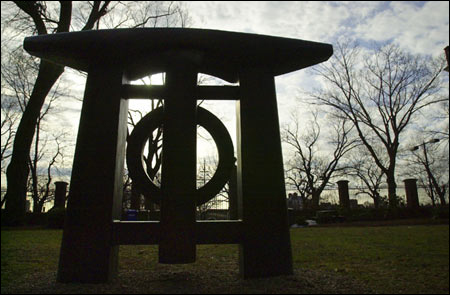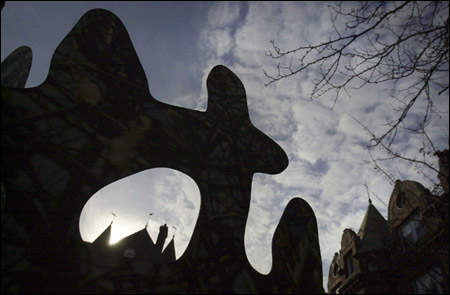New sculptures, new landscape
Two recent installations enliven spaces around the university

“Sun Gate,” a bronze sculpture weighing half a ton, arrived one day in the back of a pickup truck driven by artist Murray Dewart ’70. Dewart and his assistant, aided by a group of undergraduates, rolled the piece down the ramp and into place at the exact center of McKinlock Courtyard at Leverett House, where it seemed to command the space as though the architectural setting had been designed to receive it.
The installation was the final step in a process that had begun during the summer when Yonatan Grad, a dual M.D./Ph.D. candidate, walked through the courtyard and realized that after four years as a resident tutor he was becoming inured to its gracious neoclassic beauty.
As an amateur artist who serves as Leverett House’s tutor in art as well as medicine, Grad was troubled by his own aesthetic obliviousness. If the stress and routine of daily life could blind him to the beauty of his surroundings, it must be doing the same to others. Clearly, an intervention was in order, but what form would it take?
Grad brought up his concern during a meeting with Jack Megan, director of the Office for the Arts, and in the course of the discussion an idea emerged. Why not turn the formal rectangle of McKinlock Courtyard with its Ionic pilasters, towering elms, and river views, into a sculpture garden?
“It could be a way of changing the environment, of giving a new focus to the space, and maybe of giving people new eyes,” Grad said.

The idea also appealed to Thomas Howell, resident tutor in Adams House, and the two began thinking of ways to actualize their dream.
“We had no budget, but we had lots of energy. And we also had something that artists tend to get excited about – the chance to show their work.”
A campaign of networking and cold-calling turned up two artists who were intrigued with the idea of showing their sculpture at Harvard – Dewart and sculptor and multimedia artist Andrew Zimmermann ’75. Grad said that he and Howell made no effort to find artists who were Harvard alumni, and the fact that both turned out to be former students was “a complete coincidence.”
Zimmermann’s sculptures “Landscape Lattice” and “Tangle Lattice” can be seen in the Randolph Courtyard at Adams House. In contrast to Dewart, who tends to work in more traditional materials, Zimmermann has constructed his pieces from sheets of aluminum covered with photographic bus wrap, a thin vinyl film more commonly used in advertising. Zimmermann’s fuzzy enlargements of shrubbery, power stations, and construction sites create a multileveled viewing experience in which the two-dimensional images and the three-dimensional courtyard can be glimpsed through the interstices of the aluminum forms.
“The courtyard makes a good setting for the pieces because it combines both the built and organic. It’s a nice harmony,” said Zimmermann.
Zimmermann’s latest works, which combine sculptural forms with animation, can be seen in downtown Boston, one at the corner of Washington and Avery streets, the other at Washington and Tremont. Go at night to get the full effect.
Dewart has been making gates for more than a decade and has just completed two large ones in China. For him, they are metaphors about passage.
“One of the things that artists give to the world is metaphor,” he said. “What we’re always seeking is a universal language, but we don’t always know if we’ll find it.”
He said that whether a sculpture works or not depends on whether the sculptor has been able to pour his or her life energy into the inanimate materials of which it is made. When that transfer of energy succeeds, he said, the sculpture embodies what the poet Wallace Stevens described as “… the life/That is fluent in even the wintriest bronze.”
The work of Dewart and Zimmermann will be on display through January. After that, who knows?
“We’re hoping that we’re inaugurating a tradition,” Grad said.




